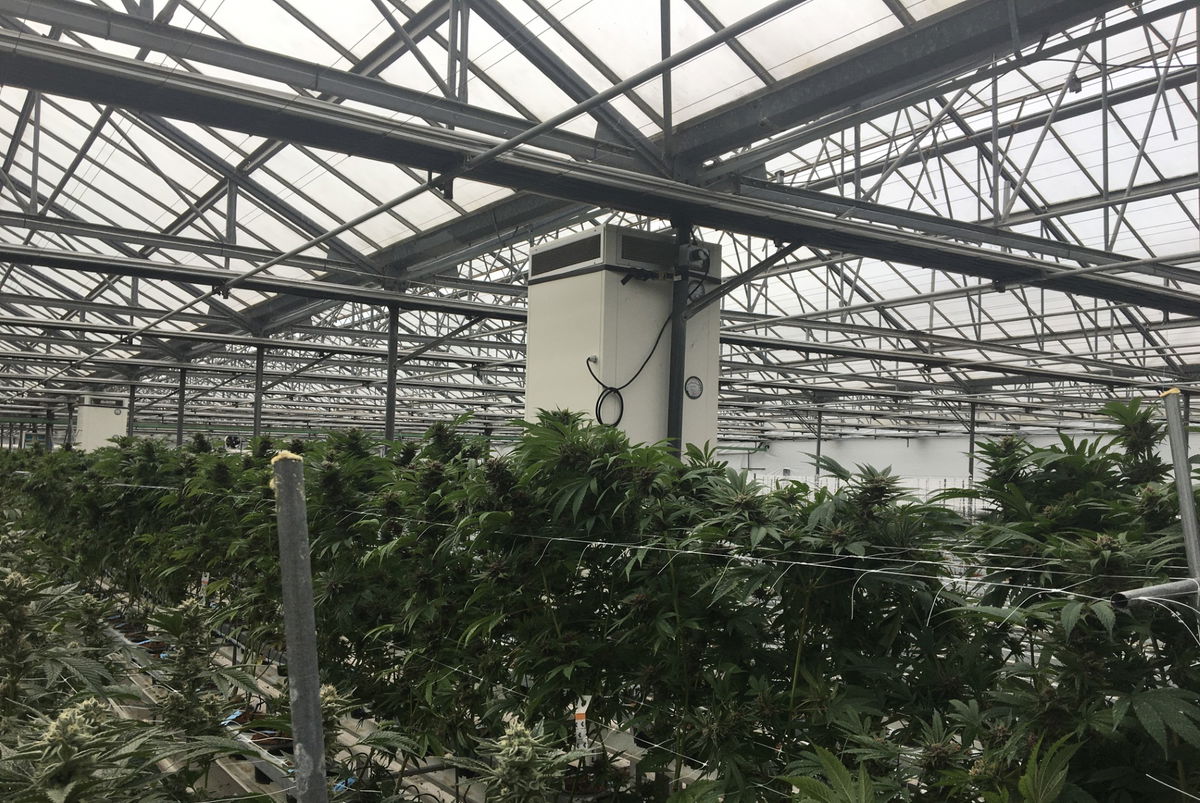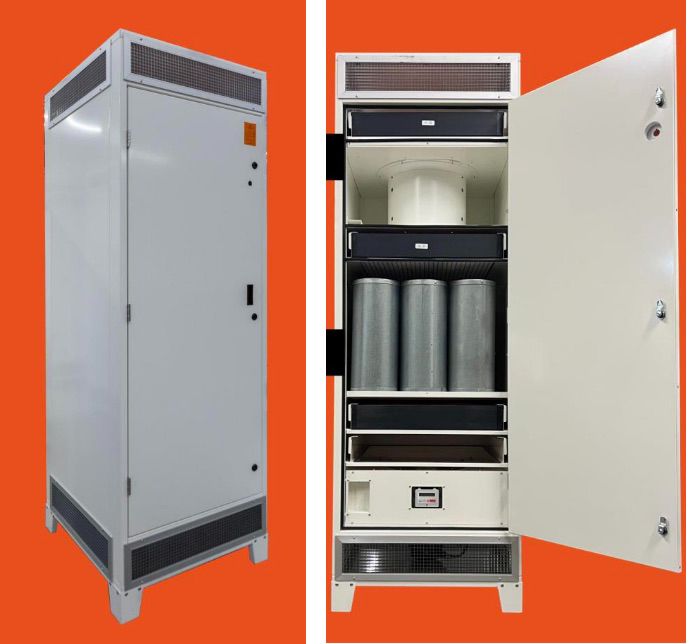Fine-Tuning Strict Odor Controls for Cannabis Greenhouses

CARPINTERIA, Calif. – Working on a fast track, the county Planning Commission on Wednesday tentatively endorsed a county Board of Supervisors proposal that would require the installation of state-of-the-art odor control technology inside every cannabis greenhouse in the Carpinteria Valley.
Under the proposal, which will return to the commission for a vote on Feb. 19, valley growers would have 12 months to install carbon filters known as “scrubbers” — or an equivalent technology — that can eliminate most of the “skunky” smell of pot before it escapes through the greenhouse roof vents. At the same time, growers would be required to shut down the perfumed “misting” systems that they’re currently using to neutralize the smell of pot after it escapes into the outside air.
Carpinterians have filed 3,900 odor complaints to the county since the cannabis ordinance was approved in 2018, county records show. But it has been impossible to determine which cluster of greenhouses is to blame.
“I think they’re demanding no odor at the property line,” said Commissioner Roy Reed, who represents Orcutt and Los Alamos. “… It’s become abundantly clear that multi-technology carbon scrubbers are going to be a definite requirement. The misting systems need to go away. They struck me as somebody needing to take a shower covering it up by using cologne … We really need to listen to the neighbors and the City of Carpinteria and pursue these more aggressive goals.”
To date, records show, the county has approved zoning permits for 27 cannabis greenhouse operations in the valley, covering 138 acres just outside the city limits of Carpinteria, a beach town of about 13,000 people. Cannabis is currently under cultivation at 20 operations on 120 acres. Of the 20 active cannabis “grows,” only seven are equipped with scrubbers.
“We’re looking at you to protect us,” said Paul Roberts, who lives on La Mirada Drive, a hot spot for the pungent smell of pot in the foothills of the valley. “I had to close our windows two weeks ago at 4 in the morning, and we live more than a mile from any growers … There’s a large, invisible community that is vigorously concerned about this pollution issue.”
Property Line Testing
On Wednesday, the commission also expressed support for a county Planning & Development proposal to require testing for the smell of pot along the property lines of greenhouse operations. Certified inspectors would sniff the air through Nasal Rangers, handheld gadgets that fit over the nose and look like household hair dryers. The testing would be triggered by three complaints from residents within 60 days or five complaints within 24 hours.
The odor threshold for compliance is still to be defined. Some members of Concerned Carpinterians and the Santa Barbara Coalition for Responsible Cannabis — two citizens’ groups in the valley that have advocated for tighter regulation of the industry — contend that there should be “zero” smell at the greenhouse property lines. Noting that some greenhouse operations share the same property lines, they favor testing at the roof vents, before the smell can be dispersed on the wind, making it harder to pinpoint the source. Planning & Development is proposing a threshold at which the smell of pot would be “noticeable” at the property line.
Jill Stassinos, a 30-year resident of Carpinteria, told the commission that the county should revoke the business licenses of growers who fail to install scrubbers in a timely fashion.
“Without enforcement and consequences, nothing will change, and the cannabis growers will continue to drag their feet,” she said.
In addition, the City of Carpinteria is asking the county to replace its complaint-based system with a “proactive enforcement approach,” implementing regular odor monitoring of every greenhouse operation at different hours, including early morning and late evening, when the smell is most prevalent.
Planning & Development is proposing to implement quarterly inspections of carbon filters or equivalent technology in the first year after their installation; and to conduct one inspection per year afterwards, retaining the right to inspect the odor control equipment, unannounced, at any time. The growers would be required to install “run-time” meters on their odor-control equipment, showing that it was operating around the clock.
“Those quarterly inspections during the first year really give us an opportunity to dial in compliance with each operator individually,” Planning & Development Deputy Director Errin Briggs told the board. “… It allows us to really get in tune with each operation and understand what it is that they’re doing.”
Finally, as proposed, growers could apply for extensions on the 12-month deadline for scrubber installation if they faced delays because of power upgrades or equipment supply chain problems. Here, too, the citizens’ groups favor more stringent rules — no extensions should be allowed, they say, noting that the growers have had seven years to get the smell under control.
The odor control proposal is on track to come before the Board of Supervisors in March as a package of amendments to the county’s cannabis ordinance and zoning code. It would then need state Coastal Commission approval, a process that could take months.
The “Smell Snorkel”
Jared Ficker, a spokesman for CARP Growers, a group that encompasses roughly three-fourths of the valley’s cannabis operations, reminded the commission on Wednesday that its members had pioneered the state-of-the-art scrubber technology that has proven effective in removing much of the smell inside greenhouses. In late 2022, independent testing of a model developed for the valley by the Envinity Group, an air purification engineering firm based in the Netherlands, showed that it could remove 84 percent of the smell of pot, on average, inside a cannabis greenhouse.
Ficker said CARP Growers supports carbon scrubbers and a phase-out of the misting systems that operators “spent a lot of money chasing” early on. But many growers have experienced “great delays” in trying to revise their odor control plans and process basic building and electrical permits for scrubbers, Ficker said. Some power upgrades have been “pending for multiple years,” he said.
“First and foremost, let’s get the equipment installed,” Ficker said.

At Wednesday’s hearing, the commissioners also heard some skepticism as to whether Nasal Rangers were the best technology for testing at the greenhouse property lines. Kapono Curry, an agent for cannabis growers, said he was certified to use the technology — he called it a “smell snorkel” — and had found that different users can have different sensitivities to the smell of pot.
Moreover, Curry told the commission, “An individual operator’s sensitivity goes up or down on a daily basis.” It takes about 40 samples to get a reliable, unbiased recording, he said, and each sample takes about 10 minutes to complete. The temperature, wind direction and time of day must be recorded, too.
Last April, in a report the Board of Supervisors on hundreds of odor samples taken with Nasal Rangers at the property lines of cannabis greenhouses in the valley, Planning & Development stated that “the use of a Nasal Ranger in the field has limitations.” According to the manufacturer, the ideal use of the technology is in a lab setting, the report said.
On Wednesday, noting that the Nasal Ranger is “not perfect,” Commissioner John Parke, who represents the Santa Ynez Valley, said he wanted to ensure that property line testing would occur in response to nighttime complaints. Greenhouse operators periodically open their rooftop vents wide to let out hot air that can damage their plants. These “burping” events can occur very early in the morning, sending the smell of pot wafting into sleeping neighborhoods.
“We have to have the ability to react on a real-time basis,” Parke said.
Parke also asked Planning & Development to explain on Feb. 19 why Nasal Rangers should be employed rather than gas chromatography, a technology that can separate out the different chemical compounds that make up an odor plume of cannabis. Gas chromatography has been used privately in the valley on numerous occasions to help settle lawsuits, aid growers in applying for permits and monitor the smell of cannabis at harvest time. It can track how far the odor from cannabis greenhouses is traveling, and under what concentrations and wind conditions.
Melinda Burns is an investigative journalist with 40 years of experience covering immigration, water, science and the environment. As a community service, she offers her reports to multiple publications in Santa Barbara County, at the same time, for free.
